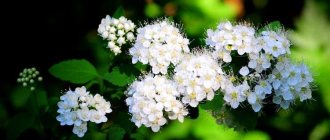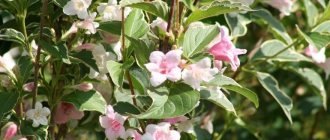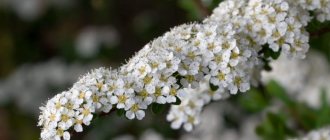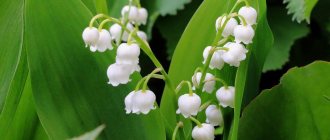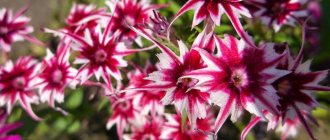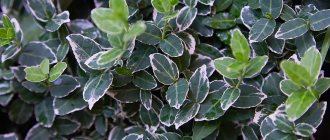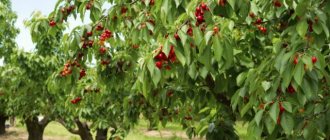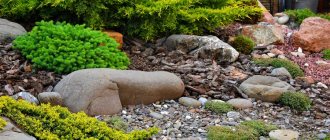Spiraea is an unpretentious and flexible ornamental deciduous shrub, sometimes called meadowsweet. It can grow almost everywhere and has about a hundred species and varieties. The spirea shrub is distinguished by its beautiful and spectacular appearance, frost resistance, characteristic small flowers, and flexible stems.
A shrub completely covered with white flowering balls is one of the most attractive varieties of spirea
Reasons for the popularity of spirea in landscape design
Today, spirea in landscape design is one of the most popular plants. Benefits of growing shrubs in the garden:
- Great for decorating any style of landscape.
- There are tall (over 2.5 meters) and miniature (15-25 cm) varieties of the plant.
- Suitable for creating “live” hedges, borders, garden compositions, as a tapeworm, etc.
- Blooms beautifully and luxuriantly.
- The plant is represented by varieties that bloom in spring or summer - this is an ideal option for an “ever-blooming” garden.
- Very unpretentious, it is practically not affected by pests.
- This is an excellent honey plant.
In nature, this plant lives in steppes, deserts, and semi-deserts. Shrubs vary in appearance - they are spherical, pyramidal, creeping, erect and others.
Spirea - many advantages and almost complete absence of disadvantages
Diseases and pests
Like any large flowering plant, spirea is susceptible to attacks by pests - both unique to the genus and ordinary ones, which gardeners are accustomed to seeing on their site every season.
The most important enemies of the bush are spider mites and common aphids. If ladybugs and birds can help you deal with the second, then you need to fight spider mites immediately, as quickly as possible. You can do this yourself - treat it with phosphamide or karbofos.
Also, for owners of spirea, caring for and growing them in the garden can be burdened by a variety of diseases:
- Consequences of drought or overwatering. This is not a disease, but it is because of this that spirea leaves often dry out. Have you noticed this in your area? Better watch your watering schedule.
- Verticillium is a fungal disease that can be eliminated physically, as well as by treating with the substances mentioned above.
Types, varieties of perennial shrub spirea - description with photo
The “living” spirea shrub in the photo is a lush flowering plant. It usually blooms in the third year after planting. Spring-flowering species are recommended to be planted in autumn, summer-flowering species - in autumn or spring.
Low-growing varieties of spirea are great for borders.
In spring, spirea sharp-toothed, plum-leaved, Vangutta, St. John's wort, ash (gray), medium, Nippon, Thunberga blooms. In early to mid-summer, the following types of spirea bloom: Bumalda, dwarf, birch-leaved, Billarda, Japanese. At the end of summer and early autumn, Spiraea willow, tomentosa, Douglas, and white-flowered flowers bloom.
Flowering time may vary by two to three weeks depending on the specific planting region and weather conditions.
Billard's spirea (Spiraea x billardii)
Billard's spirea is a hybrid plant descended from the Douglas and willow varieties. This is a fairly tall shrub with deviating branches, pyramid-shaped inflorescences, and pale pink flowers. This variety is used to create “living” hedges; it is usually trimmed to give the desired shape.
Spiraea Billarda is a late-flowering variety with a long flowering period.
Spiraea chamaedryfolia
This plant is highly decorative, has small jagged leaves to the base, snow-white flowers, a rounded dense crown, and ribbed shoots. Planted separately or as part of garden compositions. It grows up to two meters in height, blooms in May, bears fruit in September.
Spiraea oakleaf blooms much earlier than other varieties
Japanese spirea (Spiraea japonica)
The Japanese variety has the appearance of an upright shrub, 120-160 cm high. The leaves are ovoid, with jagged edges, about 10 cm long. The plant blooms from June to August; the varieties “damask steel” and “little princesses” are most often used for garden decoration. . In autumn, the foliage turns red, turns yellow, becomes red or purple - the plant looks beautiful until winter.
A young bush of Japanese spirea at the beginning of the flowering period
With the arrival of autumn, the spirea bush looks completely different
Spiraea salicifolia
Willow spirea grows above two meters. The ten-centimeter leaves are narrow, elongated, the inflorescences are pyramidal, consisting of many panicles, about 15 cm long, pinkish or white in color. The shrub blooms from mid-June to mid-late August.
Most types of spirea have curved branches, but willow spirea is not like that - its stems are straight
Although the flowers are small, there are a lot of them
Douglas spirea (Spiraea douglasii)
This species has a height of up to one and a half meters, straight, brown-reddish branches, leaves with white felt on the underside. It blooms in the third decade of June, the inflorescences are directed upward, colored in rich pink tones, and have a narrow pyramidal shape. In its natural environment it prefers warm, marshy places and begins to bloom at three to four years of age.
The flowering of this variety of spirea can last up to one and a half months.
Spiraea nipponica
Nippon spirea has dark foliage and creamy white flowers, collected in complex inflorescences. Flowering time is from mid-June to August, the leaves remain green until the end of autumn. The branches are directed predominantly horizontally, the crown is spherical and compact.
Spiraea nipponum blooms profusely in open sunny areas
Crenate spirea (Spiraea crenata)
The crenate variety has relatively wide toothed leaves, the inflorescences are located on small leafy side branches. The height of the bush is about a meter, the crown is loose, wide-conical. The flowers are white and yellow, flowering lasts 20-25 days. The plant is light-loving, drought-resistant, and is used in group plantings to strengthen sandy and rocky slopes.
Spiraea crenate - a small shrub with a loose crown and beautiful flowers
Spiraea Vanhouttei (Spiraea x vanhouttei)
This shrub has dark leaves and snow-white flowers on long arched branches that bend to the ground during abundant flowering. The crown is decorative, spreading, up to 180-230 cm in diameter. The leaves themselves are jagged, ovoid, dark green on top, light gray on the lower surface. Under favorable conditions and the right planting site, spirea Vangutta blooms twice a year - in spring and late summer.
Spiraea Vangutta is equally good both in single plantings and as a hedge.
It is surprising that the branches of the spirea are so strong that they do not break even when bent towards the ground under the weight of water after a heavy rainfall.
Spiraea thunbergii
Spiraea Thunberga or “snow willow” looks beautiful, but is afraid of frost. It has white small flowers resembling stars and lanceolate leaves. Flowering is early, the crown is dome-shaped, up to 190 cm in height and diameter, the fruits are small, brownish. Grows well in partial shade, on moist sandy or loamy soils. It is used for urban landscaping, as it perfectly absorbs dust and tolerates street gas pollution.
Spiraea Thunberg is a graceful shrub often called snow willow.
Spiraea Golden Princess
“Golden Princess” is a low-growing species (up to 50-60 cm), with a dense rounded crown that retains the bright yellow color of the foliage all summer. Often used in urban plantings, blooms in June-July, prefers loose soil where water does not stagnate. The flowers are pink-red, the leaves are pointed, up to seven cm long.
The Golden Princess variety is a variety of Japanese spirea.
Correct fit
Almost all representatives of the genus Spiraea are light-loving plants, but some varieties tolerate partial shade. The best time to plant this plant is September, but summer-flowering species can also be planted in the spring, and specimens with a closed root system can be planted throughout the warm season.
- The planting hole or trench (in the case of a hedge) is prepared in advance. Its dimensions should exceed the dimensions of the root system by at least one third. If the groundwater in the area is close to the surface, then a drainage layer must be placed at the bottom of the hole.
- Spiraea has no special requirements for soil; garden soil or a mixture of leaf and turf soil is perfect. Billard's spirea grows best on sandy substrates, while Japanese spirea prefers more fertile soils.
- Before planting, you need to inspect the roots of the seedling - if they are slightly dry, then you should put the plant in water for a while. Diseased and dead roots need to be removed.
- When planting, the roots of the seedling are straightened and carefully covered with substrate, without deepening the root collar.
Tips, recommendations for growing and care
Spireas are planted in the spring (immediately after the snow melts) or in the fall (before the onset of frost). The plant propagates by cuttings, layering, dividing the bush, and by seeds. When planting as part of hedges or compositions, the distance between bushes and rows is at least 40-50 cm. The average lifespan of spirea is 20-30 years, depending on the variety.
For planting in a summer cottage, it is better to choose a small seedling at the age of 2–3 years
When planting seedlings, a square hole measuring 50 by 50 cm is dug. If the soil is dense and heavy, a drainage layer of at least 10-15 cm thick must be made from coarse river sand, pebbles, and broken bricks. A suitable soil mixture contains one part peat, one part sand, two parts leaf or turf soil. Before placing the seedling in the hole, it is recommended to dip the roots in a clay solution. Afterwards, the roots are carefully covered with prepared soil, compacted, and watered with one or two buckets of water.
To plant a spirea seedling, it is advisable to choose cloudy weather.
Caring for the plant consists of regular but not excessive watering, killing weeds, and loosening the soil. Pruning is also used - preventive and decorative. Early flowering varieties are pruned immediately after flowering, shortening the shoots by about half. Old (six to seven years old) and weak shoots are removed completely. Summer-flowering varieties are pruned early in the spring, removing frostbitten branches broken during the winter, renewing the tops, and removing shoots that thicken the crown. Young plants (up to four to five years old) are pruned to the first large buds; in older plants, it is permissible to leave 30-centimeter branches.
Spiraea is a fairly frost-resistant shrub for the middle zone. In colder regions, the plant is covered for the winter by constructing a “breathing house” over it from available materials
The shrub is rarely damaged by parasites - the most dangerous are spider mites, leaf rollers, and aphids. To combat them, folk remedies and industrial pesticides are used. In order for the plant to be healthy and bloom luxuriantly, fertilizers are applied to it. This is recommended to be done in early spring; complex formulations are preferred. In cold regions, for the winter, the roots of the shrub are insulated with fallen leaves and spruce paws.
General location rules
The genus Spiraea (another popular name is meadowsweet) has approximately 100 species. These are decorative summer-flowering deciduous shrubs of the Rosaceae family. They are easy to care for and well adapted to our climatic conditions. And gardeners and designers love to plant them because of their beautiful foliage, abundant and long-lasting flowering.
In order for spirea to please you with its appearance for a long period, you need to know the basic principles of its planting:
- It can be planted both in early spring (before the start of the growing season) and in mid-autumn (the first ten days of October).
- You should choose a place for a flower garden from this plant that is sufficiently illuminated and warmed by the sun's rays (it is worth considering that the shrub forms powerful basal shoots).
- The soil must be fertile (dwarf spirea love rocky soil).
- During periods of drought, the bushes need to be watered 2 times a month, at the rate of 2 buckets of water per plant.
- The soil in the root circle must be loose so that oxygen can flow in (mulching the soil under the bush with a layer of sawdust, straw, etc. will help with this).
- Weeds need to be removed in a timely manner (they can be left under the bush for an additional mulch layer).
- In severe winters, with little snow, the root system should be protected (to do this, add a layer of foliage, straw or peat about 20 cm).
- Spiraea loves fertilizing (the first, with a mineral complex, is carried out in the spring after pruning; the second - in mid-summer, fertilized with a solution of mullein with the addition of superphosphate).
- Bushes need both formative and sanitary pruning (the first is carried out as needed, the next in early spring).
The correct planting location can be determined by the color of the leaf plate: with green leaves it is better to plant in the shade (2-3 hours of sunlight is enough), with bright and multi-colored leaves - in a illuminated area. By adhering to these simple rules of care, you will get the maximum effect from spirea.
Did you know? The beginning of the history of landscape design is considered to be the 9th century BC. e., when one of the seven wonders of the world, the “Gardens of Babylon” in Babylon, was created.
Photo examples of beautiful site design with spirea
The Japanese spirea looks most striking in the landscape design in the photo. These include the long-flowering Darts Red, dwarf Albiflora, blooming white, Bullata with wrinkled leaves, frost-resistant Crispa with a ball-shaped crown, Goldflame with golden leaves. Little princess - also planted often, usually singly. It has brown-red shoots, reddish-pink inflorescences, and high winter hardiness. The Grefsheim or gray variety, with drooping branches and snow-white flowers, is popular.
Since spireas are easy to trim, they can be used to create hedges
Living walls can be high or low, depending on the variety chosen
Spiraea combines harmoniously with many garden crops
Japanese spirea feels great on a rocky hill
Summer-blooming spireas look good with roses
Different types of spirea can be combined with each other, creating unique compositions
Spiraea plantings are “lace” hedges along the perimeter of the site, multi-colored alpine slides. Instances with arched drooping branches are planted in open areas, while pyramidal ones are used to create small alleys. The shrub feels great next to quince, apple trees, lilacs, daffodils, hydrangeas, cornflowers, and conifers. Dwarf plants are planted in the form of ridges, borders or alpine hills; varieties with a powerful root system decorate slopes in areas with a slope.
Combination with other plants
Spiraea is a universal plant for garden decoration. It can be used as a single decoration or in compositions with other flowers, bushes and trees. Therefore, at the initial stage of designing a garden plot, it is necessary to think in advance about the location of planting spirea shrubs and the location of other plants.
Did you know? The shade of hydrangea flowers depends on the acidity of the soil and the content of trace elements in it. So, on acidic soils they will be blue, on neutral ones - pink, and on medium-acidic soils - lilac or pink, and on one bush.
With hydrangea
Hydrangea is a tall plant, so when creating compositions with spirea, you need to take this into account. For such combinations, it is necessary to choose low-growing varieties of the latter so that they do not interfere with each other. They can be combined to create flower beds, hedges and as a bright garden composition, to give, for example, a monotonous green lawn a colorful look.
In our latitudes, paniculata and tree hydrangeas have proven themselves well. They withstand frost, are rarely affected by diseases and pests, and are undemanding in care.
With hosta
Hosta can act as a solitaire in the composition, while spirea is used for edge planting; or vice versa, spirea is chosen as a soloist, and shorter hostas are planted as a fence. It all depends on the designer’s preferences, the varieties of a particular plant, its characteristics, etc.
For the composition of hosta with spirea, it is also better to choose low-growing varieties. They can be combined in a checkerboard pattern to create a beautiful border along the garden path, or planted as the edging of a flower bed.
With weigela
The spirea-weigela duet looks great on the site. Varieties with simultaneous flowering will combine especially well. They can be arranged in different ways, it all depends on the size of the plot and the personal preferences of the owner.
Gray spirea can be planted next to low roses, peonies, and carnations. Varieties with yellow foliage perfectly complement red Japanese maples. Bushes of viburnum, lilac or broom go well with white flowers.
This wonderful shrub will help you decorate your garden and make it unique. A landscape designer’s flight of fancy is all you need to create a beautiful garden or summer cottage. Planting spirea as a lawn primrose or creating a picturesque border or hedge is a wonderful choice for elegant decor that is not very difficult to care for.
